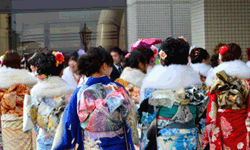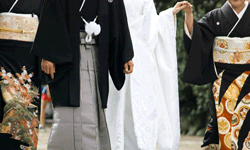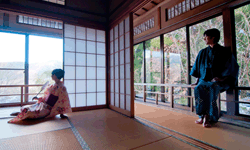


【Outline of Kimono】
Kimono is a Japanese traditional garment. The word “kimono” actually means a “thing to wear” (ki “wear” and mono “thing”).
Kimono has a long history, but current style of Kimono seemed to be established in Edo period (1603
– 1868). Kimonos are T-shaped and straight-lined robes. Therefore, it can be easily reformed when the size of someone’s body would change or if the Kimono should be given to other people. In old days, Kimono was often worn in long
time or by many people by such reform, which would be often done even nowadays for very expensive Kimono inherited by someone’s ancestors.
There are a lot of Kimono materials such as Chijimi, Chirimen, Rinzu, Sha, Silk,
or Tsumugi and a lot of producing methods such as Arimatsu-shibori, Yuki-Tsumugi, Yonezawa Benibana-dying or Kyoto’s Nishijin-Ori. Silk is the most famous material for Kimono and it was a big exporting product for modern Japan after ending the isolation policy in Meiji era (1868 – 1912). To visit each
Kimono’s material producing place would be exciting to learn Japanese traditional industry.
Today, Kimonos is most often worn by women and on special occasions. There are some kinds of Kimono. One example is a style
of kimono called “Furisode”, having almost floor-length sleeves. Traditionally, it is worn by unmarried women on special occasions, such as on a coming-of-age ceremony (the second Monday of January), a graduation ceremony of university
(March) or a wedding ceremony.
Secondly, there is a style of “Tomesode”, especially “Black-Tomesode”, having 5 family crests one on the back, two each on breast and sleeve position. It is worn as a formal dress by a
married woman usually on their child’s wedding. “Colored-Tomesode” is also a formal dress both for married and unmarried women, having only one family crest or three or five crests depending on the occasion.
There are
many other style of Kimono such as “Homon-gi (Official visiting Kimono)”, “Komon (Daily Kimono) or “Meisen (Fancy Daily Kimono) , “Yukata” etc. “Yukata” would be familiar even for foreign tourists. It is known as a summer wear
and for general relaxation and as sleeping wear in “Ryokan” or Japanese style inn. It is also commonly worn at a local summer festival and fireworks displays. Professional sumo wrestlers are often seen in Kimono or Yukata because
they are required to wear traditional Japanese dress whenever appearing in public.
To wear Kimono, there are some other small articles such as a sash called an Obi, which is tied at the back with a Obijime (holding the
Obi in position) and a Obiage (supporting the Obi too), traditional footwear (especially Zōri or Geta) and split-toe socks (Tabi). Underwear, some hidden strings and other articles are also used when wearing Kimono, while Yukata
needs less articles. Such small articles, especially, Obi, Obijime and Obiage are also made by using traditional Japanese techniques.